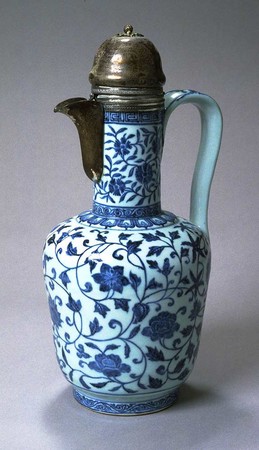"Silk Road to Clipper Ship: Trade, Chang ing Markets and East Asian Ceramics" au Kalamazoo Institute of Arts
Blue-and-White Ewer with Silver Fittings, China, early 15th century, Porcelain with underglaze blue painting
KALAMAZOO, MI.- A new exhibition at the Kalamazoo Institute of Arts demonstrates the impact of the exchange of goods, people and ideas on Chinese potters, and their counterparts in Japan, over nearly two thousand years of history. Silk Road to Clipper Ship: Trade, Changing Markets and East Asian Ceramics opens Saturday, September 8 and continues through Sunday, November 25.
Throughout recorded history, the technical and material superiority of Chinese ceramics has made them prized commodities, within China and throughout the world. Many critics mistakenly believe that China’s magnificent ceramic tradition developed in splendid isolation, but foreign trade played a key role in shaping the history of this art form. The works in this exhibition illustrate three historical phases in East Asian ceramic production.
Exchanges along the Silk Road explores the exchange of ideas and goods between China and Iran and the Mediterranean on the overland route that came to be known as the Silk Road, from the first through the tenth centuries of the Common Era. The Silk Road trade impacted Chinese art through the introduction of new subjects to the artists’ repertoire, exposure to new materials – such as cobalt from Iran – and technical experimentation, especially in the development of new glaze effects. At the opposite end of the trade route, Rome and Persia eagerly sought out Chinese ceramics, which were more durable and beautiful than the pottery available locally.
Tea Wares and the Ceramics Trade within East Asia focuses on the beginnings of a certain type of black glaze and its lasting importance for tea bowls and other wares associated with the tea ceremony. The Chinese Song dynasty emperor Huizong (reigned 1100-1126) declared that black-glazed bowls were best for drinking tea, giving instant prominence to the thickly glazed black stonewares from southeastern China. Another individual who greatly influenced the history of tea wares was the Japanese tea master Sen no Rikyû (1522-1591), who advocated the use of simple materials and “found objects,” and is credited with nurturing the creation of Raku ware.
The largest section of the exhibition, Asian Porcelains for Foreign Markets, presents the vividly colored porcelains of Ming (1368-1644) and Qing (1644-1912) dynasty China and their Japanese counterparts. From the 14th century onward, Chinese potters mastered an extraordinary range of colors for ceramic glazes, from “chicken fat yellow” and “peachbloom” to “teadust” green, deep reds and all shades of blue. Blue-and-white wares were made possible when the Mongols reopened trade with Central Asia in the late 13th century and came to be cherished and imitated throughout the civilized world.
This exhibition is organized and circulated by the University of Michigan Museum of Art (UMMA). Founded in 1946, UMMA owns collections of nearly 18,000 works of art in the Western, Asian and African traditions, including works by great masters and from the key schools and movements in these cultures.  Silk Road to Clipper Ship: Trade, Changing Markets and East Asian Ceramics is free of charge and open during the KIA’s normal gallery hours: Tuesday through Saturday from 10 a.m. to 5 p.m., and Sunday from noon to 5 p.m. (by courtesy of www.Artdaily.org)
Silk Road to Clipper Ship: Trade, Changing Markets and East Asian Ceramics is free of charge and open during the KIA’s normal gallery hours: Tuesday through Saturday from 10 a.m. to 5 p.m., and Sunday from noon to 5 p.m. (by courtesy of www.Artdaily.org)
Caparisoned Horse, China, about 525–530, Earthenware with traces of polychrome pigments.

/https%3A%2F%2Fprofilepics.canalblog.com%2Fprofilepics%2F1%2F0%2F100183.jpg)
/https%3A%2F%2Fstorage.canalblog.com%2F03%2F02%2F119589%2F96711876_o.jpg)
/https%3A%2F%2Fstorage.canalblog.com%2F11%2F31%2F119589%2F94773502_o.jpg)
/https%3A%2F%2Fstorage.canalblog.com%2F20%2F83%2F119589%2F94772815_o.jpg)
/https%3A%2F%2Fstorage.canalblog.com%2F26%2F72%2F119589%2F75604929_o.jpg)
/https%3A%2F%2Fstorage.canalblog.com%2F59%2F60%2F119589%2F26458628_o.jpg)



/image%2F1371349%2F20240418%2Fob_ac5c4c_telechargement.jpg)
/image%2F1371349%2F20240418%2Fob_709b64_304-1.jpg)
/image%2F1371349%2F20240418%2Fob_22f67e_303-1.jpg)
/image%2F1371349%2F20240417%2Fob_9708e8_telechargement.jpg)